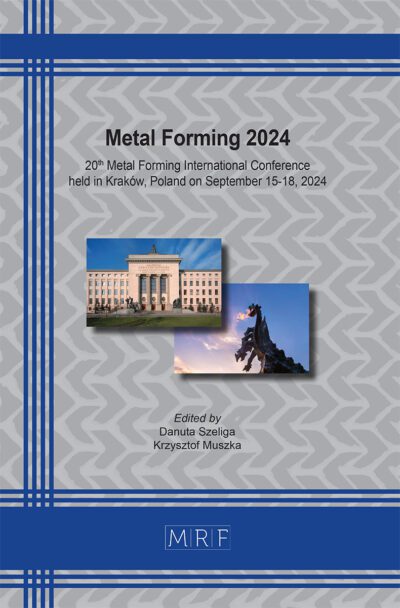Numerical modeling for forming of woven composites based on 3D strain gradient elasticity
Deyong Sun, Shuyuan Li, Shan Tang, Weizhao Zhang
Abstract: To accurately simulate the forming process of woven composites, various constitutive laws of woven composites based on continuum mechanics have been developed to capture the complex deformation behaviors of the materials. However, spurious wrinkles may occur in the simulation of 3D bending deformation due to the relatively low plane shear stiffness compared to the fiber compression. In this paper, the 3D constitutive law is established based on the strain gradient theory to capture bending deformation properties of woven composites. It can be generally applied to numerical analysis through different length-scales, including microscale, mesoscopic and macroscale. Meanwhile, this constitutive law is newly implemented into the commercial finite element software Abaqus/Explicit in the form of a user defined subroutine VUEL.
Keywords
Numerical Modeling, Composite Forming, Constitutive Law, Strain Gradient Elasticity, Wrinkles
Published online 5/7/2025, 10 pages
Copyright © 2025 by the author(s)
Published under license by Materials Research Forum LLC., Millersville PA, USA
Citation: Deyong Sun, Shuyuan Li, Shan Tang, Weizhao Zhang, Numerical modeling for forming of woven composites based on 3D strain gradient elasticity, Materials Research Proceedings, Vol. 54, pp 381-390, 2025
DOI: https://doi.org/10.21741/9781644903599-42
The article was published as article 42 of the book Material Forming
![]() Content from this work may be used under the terms of the Creative Commons Attribution 3.0 license. Any further distribution of this work must maintain attribution to the author(s) and the title of the work, journal citation and DOI.
Content from this work may be used under the terms of the Creative Commons Attribution 3.0 license. Any further distribution of this work must maintain attribution to the author(s) and the title of the work, journal citation and DOI.
References
[1] D. Che, I. Saxena, P. Han, P. Guo, K. F. Ehmann, Machining of Carbon Fiber Reinforced Plastics/Polymers: A Literature Review, Journal of Manufacturing Science and Engineering,136 (2014). https://10.1115/1.4026526
[2] M. Wang, Q. Kang, N. Pan, Thermal conductivity enhancement of carbon fiber composites, Applied Thermal Engineering,29 (2009) 418-21. https://10.1016/j.applthermaleng.2008.03.004
[3] J. R. Smith, U. K. Vaidya, J. K. Johnstone, Analytical modeling of deformed plain woven thermoplastic composites, International Journal of Material Forming,7 (2013) 379-93. https://10.1007/s12289-013-1133-z
[4] X. Peng, J. Cao, A dual homogenization and finite element approach for material characterization of textile composites, Composites Part B: Engineering,33 (2002) 45-56. https://https://doi.org/10.1016/S1359-8368(01)00052-X
[5] D. Sun, W. Zhang, J. Zou, Y. Xiong, C. Tang, W. Zhang, Coupled 3D non-orthogonal constitutive model for woven composites in preforming and compaction processes, Manufacturing Letters,41 (2024) 412-20. https://10.1016/j.mfglet.2024.09.049
[6] W. Zhang, H. Ren, B. Liang, D. Zeng, X. Su, J. Dahl, et al., A non-orthogonal material model of woven composites in the preforming process, CIRP Annals,66 (2017) 257-60. https://10.1016/j.cirp.2017.04.112
[7] P. Xue, X. Peng, J. Cao, A non-orthogonal constitutive model for characterizing woven composites, Composites Part A: Applied Science and Manufacturing,34 (2003) 183-93. https://https://doi.org/10.1016/S1359-835X(02)00052-0
[8] S. Mathieu, N. Hamila, F. Bouillon, P. Boisse, Enhanced modeling of 3D composite preform deformations taking into account local fiber bending stiffness, Composites Science and Technology,117 (2015) 322-33. https://https://doi.org/10.1016/j.compscitech.2015.07.005
[9] S. S. Gao, Z. T. Qu, Y. J. Zhang, Z. Z. Zhao, B. Liang, An efficient hyper-elastic model for the preforming simulation of Carbon-Kevlar hybrid woven reinforcement, Chinese Journal of Aeronautics,35 (2022) 321-35. https://10.1016/j.cja.2022.05.007
[10] R. Bai, E. Guzman-Maldonado, R. Zheng, J. Colmars, Influence of in-plane bending behaviour on textile composite reinforcement forming, International Journal of Mechanical Sciences,273 (2024). https://10.1016/j.ijmecsci.2024.109206
[11] P. Boisse, N. Hamila, A. Madeo, The difficulties in modeling the mechanical behavior of textile composite reinforcements with standard continuum mechanics of Cauchy. Some possible remedies, International Journal of Solids and Structures,154 (2018) 55-65. https://https://doi.org/10.1016/j.ijsolstr.2016.12.019
[12] A. H. Sakhaei, S. Erland, T. J. Dodwell, A finite deformation Cosserat continuum model for uncured carbon fibre composites, Mechanics of Materials,151 (2020) 1-12. https://10.1016/j.mechmat.2020.103611
[13] G. Barbagallo, A. Madeo, F. Morestin, P. Boisse, Modelling the deep drawing of a 3D woven fabric with a second gradient model, Mathematics and Mechanics of Solids,22 (2016) 2165-79. https://10.1177/1081286516663999
[14] E. De Luycker, N. Hamila, Modeling of hyperelastic bending of fibrous media using second-gradient isogeometric analysis: Weaving and braiding applications, Composites Part A: Applied Science and Manufacturing,167 (2023). https://10.1016/j.compositesa.2022.107415
[15] Z. Zhao, K. Zhang, H. Cheng, Y. Zeng, B. Liang, Experimental characterization and numerical modelling of bending behavior of carbon fiber unidirectional thermoset prepregs, Journal of Reinforced Plastics and Composites,43 (2023) 277-92. https://10.1177/07316844231161397
[16] A. J. Thompson, J. P. H. Belnoue, S. R. Hallett, Modelling defect formation in textiles during the double diaphragm forming process, Composites Part B: Engineering,202 (2020). https://10.1016/j.compositesb.2020.108357
[17] B. Liang. Experimental and numerical study of the bending behaviour of textile reinforcements and thermoplastic prepregs 2016.
[18] B. Liang, P. Chaudet, P. Boisse, Curvature determination in the bending test of continuous fibre reinforcements, Strain,53 (2016). https://10.1111/str.12213
[19] H. Xiong, N. Hamila, P. Boisse, Consolidation Modeling during Thermoforming of Thermoplastic Composite Prepregs, Materials (Basel),12 (2019). https://10.3390/ma12182853
[20] A. Rashidi, J. P. H. Belnoue, A. J. Thompson, S. R. Hallett, A. S. Milani, Consolidation-driven wrinkling in carbon/epoxy woven fabric prepregs: An experimental and numerical study, Composites Part A: Applied Science and Manufacturing,143 (2021) 106298. https://https://doi.org/10.1016/j.compositesa.2021.106298
[21] D. C. C. Lam, F. Yang, A. C. M. Chong, J. Wang, P. Tong, Experiments and theory in strain gradient elasticity, Journal of the Mechanics and Physics of Solids,51 (2003) 1477-508. https://10.1016/s0022-5096(03)00053-x
[22] A. J. Thompson, B. El Said, D. Ivanov, J. P. H. Belnoue, S. R. Hallett, High fidelity modelling of the compression behaviour of 2D woven fabrics, International Journal of Solids and Structures,154 (2018) 104-13. https://https://doi.org/10.1016/j.ijsolstr.2017.06.027
[23] ABAQUS Version 6. Providence, RI, USA: Dassault Systèmes; 2017.













